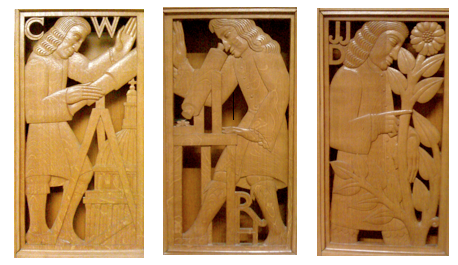Ask nicely, or take along a student with a library card, and you might be able to get into the Radcliffe Science Library on Parks Road. This is very much a working part of Oxford University and tourists are not encouraged, but this building, as well as housing a remarkable collection of scientific tomes, is also the home of a rather special work of 20th century art.
On the first floor, you will find two screens forming the original sliding doors to the Rare Book Room. These screens, composed of six panels carved in low relief of scientists with a strong Oxford connection, were designed and carved by Eric Gill and his assistant Donald Potter in 1935.
Carved front and back from a single piece of wood, each of the oak panels is pierced with the original intention that they should be looked through, like a grill, to the Rare Books Room beyond. However, time marched on and those rare books were moved to a safer location and the room beyond the grill became the office of the Chief Librarian who also goes by the illustrious title of Keeper of Scientific Books.
Five of the six panels portray almost household names when it comes to science. At the top, we are shown Roger Bacon, the Franciscan Friar who was a student and then a master at the University and an early European advocate of the scientific method. We also have William Harvey who is shown holding a human heart to remind us that he discovered and documented the circulation of blood. On the left hand door we also have the two Oxford Roberts—Hooke and Boyle—with their microscope and laboratory glassware respectively. And on the right, we have Sir Christopher Wren with the mighty dome of St. Paul’s Cathedral in the background and his telescope in front. Remember, he was the Professor of Astronomy in Oxford before he was an architect. But, who is the sixth Oxford scientist in the bottom panel? All the portraits are highly stylised and are identified only by the initials of their subject. The last is ‘JJD’. I pondered over this one, but the carving of the wigged man in 18th century garb, with his sunflower did not help. After surrendering to the typed up key, on the wall to the right of the screens, I discovered this to be Johann Jakob Dillenius. I was, I regret to say, none the wiser.
It turns out that the man with the sunflower was an 18th century German botanist who was appointed as the first Sherardian Professor of Botany at the University of Oxford. He was highly regarded by the likes of Linnaeus, who even named a genus of tropical tree after him. But, it’s hardly the dome of a cathedral or a law of physics is it? It does rather smack of desperation, I thought, that after the usual scientific suspects had been rounded up and immortalised in oak, one that few have heard of was included, just to make up the numbers.
Thinking this, I suddenly felt sorry for Dillenius having to share the screens with five legends, and having to endure the ignominy that must sting every time someone who admires these panels gets to his portrait and mutters, ‘who?’
Who else could have been chosen? In 1935, Dorothy Hodgkin had still to win her Nobel Prize in Chemistry—indeed she had just arrived in Oxford the year before to take up a post-doctoral research fellowship. Florey and Chain were five years away from purifying penicillin, Erwin Schrödinger, the physicist with a fondness for cats, had arrived the year or two before the doors were carved but was only briefly a Fellow of Magdalen, while Tim Berners-Lee, who would give us the world wide web, and Stephen Hawking, his thoughts on the History of Time, were still to be born.
But what of the likes of Edmund Halley, the 18th century Astronomer Royal of comet fame or even Jethro Tull, the pioneering agriculturalist and inventor? Both had strong Oxford connections and might have stood the test of time a little more robustly than Dillenius.
However, the reason I had blagged my way into the library was not because of the subjects of the screen, but because of its creator. The artist Eric Gill is now known mostly through his font design—look on any word-processing package and you will likely find his eponymous typeface, Gill Sans, as an option. And, you will find Perpetua, which he also designed. As well as being a typographer, he was a graphic artist, sculptor and printmaker, designing such diverse commissions as the statuary outside the old BBC building in London and the definitive stamps of King George VI. He has countless war memorials and signage to his name in Oxford, London and beyond.
His religious fervour was perhaps the reason he was involved in so many ecclesiastical projects, and his sexual proclivities the explanation for his abundant erotica. His personal sex life was exuberant as well as incestuous and he scandalised even the bohemian society in which he lived. Indeed, his sexuality has for many overshadowed and sullied his body of work. If you like his work, as I do, it becomes necessary to separate the artistry before you and the man who created it. You do not need to admire, or even like, the latter to love the former.
And it is this notion of separation, which is important here. Although the screen commemorates six (or at least five) legendary scientists, it is really their work that is being celebrated, not the men themselves. Just as Gill’s work should not be viewed through a filter of moral judgement about his personal life, we should be able to marvel at Wren’s architecture free from any concern about his freemasonry, or feel a pulse without having to think about Harvey’s obsessive bird-watching.
We live in a society much affected by the cult of celebrity—a cult that relies on the personification of achievement. This is bad enough, but becomes particularly inane when the ‘achievement’ in question is simply being famous itself. Think of the pseudo-celebrities and game show contestants who fill the pages of pulp magazines. It is important to separate the work from the person, and to judge the work in distinction from the worker. If we do this it may quickly become apparent that there is no work to celebrate.
Here, Gill focussed on the people and portrayed them with an example of their greatest work. Perhaps he could have let the work stand for itself, but he chose not to. There is celebrity in science, just as in any other sphere of human endeavour, and although we should be more interested in the idea than the thinker, the provenance of the thought may influence how much credence we give it. After all, if I had not known that Eric Gill had designed these screens would I have made the effort to see them?
© Allan Gaw 2014
This is an extract from my newly published book, ‘Tales from an Oxford Bench’ now available for Kindle download from amazon.
My books available on kindle:









